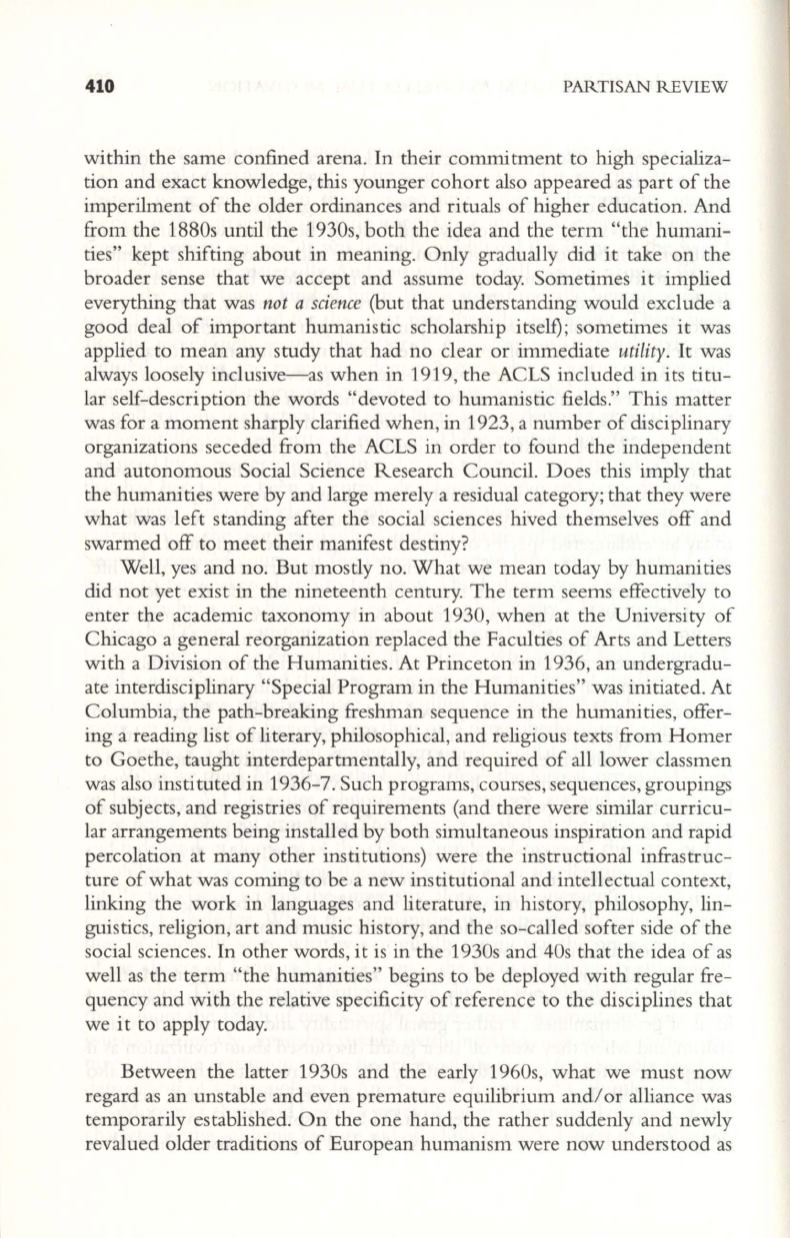
410
PARTISAN REVlEW
within the same confined arena.
In
their commitment to high specializa–
tion and exact knowledge, this younger cohort also appeared as part of the
imperilment of the older ordinances and rituals of higher education. And
from the 1880s until the 1930s, both the idea and the term "the humani–
ties" kept shifting about in meaning. Only gradually did it take on the
broader sense that we accept and assume today. Sometimes it implied
everything that was
not a science
(but that understanding would exclude a
good deal of important humanistic scholarship itself); sometimes it was
applied to mean any study that had no clear or immediate
utility.
It
was
always loosely inclusive-as when in 1919, the ACLS included in its titu–
lar self-description the words "devoted to humanistic fields." This matter
was for a moment sharply clarified when, in 1923, a number of disciplinary
organizations seceded from the ACLS in order to found the independent
and autonomous Social Science Research Council. Does this imply that
the humanities were by and large merely a residual category; that they were
what was left standing after the social sciences hived themselves off and
swarmed off to meet their manifest destiny?
Well, yes and no. But mostly no. What we mean today by humanities
did not yet exist in the nineteenth century. The term seems effectively to
enter the academic taxonomy in about 1930, when at the University of
Chicago a general reorganization replaced the Faculties of Arts and Letters
with a Division of the Humanities. At Princeton in 1936, an undergradu–
ate interdisciplinary "Special Program in the Humanities" was initiated. At
Columbia, the path-breaking freshman sequence in the humanities, offer–
ing a reading list of literary, philosophical, and religious texts from Homer
to Goethe, taught interdepartmentally, and required of all lower classmen
was also instituted in 1936-7. Such progranls, courses, sequences, groupings
of subjects, and registries of requirements (and there were sinlliar curricu–
lar arrangements being installed by both simultaneous inspiration and rapid
percolation at many other institutions) were the instructional infrastruc–
ture of what was coming to be a new institutional and intellectual context,
linking the work in languages and literature, in history, philosophy, lin–
guistics, religion, art and music history, and the so-called softer side of the
social sciences.
In
other words, it is in the 1930s and 40s that the idea of as
well as the term "the humanities" begins to be deployed with regular fre–
quency and with the relative specificity of reference to the disciplines that
we it to apply today.
Between the latter 1930s and the early 1960s, what we must now
regard as an unstable and even premature equilibrium and/ or alliance was
temporarily established. On the one hand, the rather suddenly and newly
revalued older traditions of European humanism were now understood as


